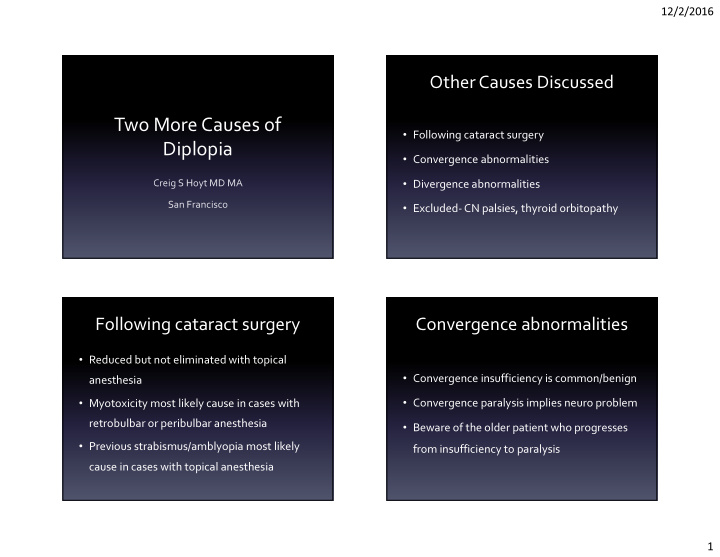



12/2/2016 Other Causes Discussed Two More Causes of • Following cataract surgery Diplopia • Convergence abnormalities • Divergence abnormalities Creig S Hoyt MD MA San Francisco • Excluded- CN palsies, thyroid orbitopathy Following cataract surgery Convergence abnormalities • Reduced but not eliminated with topical • Convergence insufficiency is common/benign anesthesia • Myotoxicity most likely cause in cases with • Convergence paralysis implies neuro problem retrobulbar or peribulbar anesthesia • Beware of the older patient who progresses • Previous strabismus/amblyopia most likely from insufficiency to paralysis cause in cases with topical anesthesia 1
12/2/2016 Divergence abnormalities Case Number One • 36 year old complains of double vision with • Divergence insufficiency in young patients slight horizontal and vertical displacement implies neuro problem- subclinical 6th nerve that overlaps the other image. The second • Divergence insufficiency in older patients with image is described as “faint”. or without myopia is usually benign • What is the diagnosis? 2
12/2/2016 Differences in Pictures • Presence or absence of cyclotorsion! • Is the second image “faint”? • Do the images overlap? • How confusing is the double vision? 3
12/2/2016 Monocular Diplopia • Second image- “faint” or “ghost” • Overlap the rule; complete separation rare Little or no cyclotorsion • • Persists with occlusion of fellow eye • Disappears with pinhole 4
12/2/2016 Monocular Diplopia • Most common cause of diplopia in general eye practice — 25% of diplopia cases • Most common cause — refraction problem not just astigmatism errors • Other causes — cornea, lens, retina Case Number Two Monofixation Syndrome • Stable less than 8 PD horizontal deviation • 46 year old man – sudden onset diplopia • Good fusional vergence amplitudes • 16 PD ET; 2 PD right HT with OA IO • Facultative suppression scotoma non-fixing • Ductions and versions — no limitations • OD 20/25 +2.00 + 1.50 x 067 • Peripheral fusion with low grade stereo • OS 20/20 +.50 + .25 x 101 • Inability to convert to bifoveation with Tx • Otherwise unremarkable exam 5
12/2/2016 Etiology of MFS MFS IS NOT STABLE • Previously treated strabismus • 10% per decade after 40 yo develop diplopia • Anisometropia with strabismus • Fusional vergence amplitudes decrease • Unilateral macular lesion • May be related to accommodation change • Primary or idiopathic- FH is important • Often have small vertical Case Number Two Case Number Two • 46 year old — early presbyopia • 46 year old man – sudden onset diplopia • Horizontal deviation with small vertical deviation • 16 PD ET; 2 PD right HT with IO OA with inferior oblique overaction • Ductions and versions – no limitations • Ductions and versions — no limitations • Anisometropia • OD 20/25 +2.00 + 1.50 x 067 • No history of strabismus or amblyopia Tx • OS 20/20 +.50 +.25 x 101 6
12/2/2016 CONCLUSIONS CONCLUSIONS • 1. Monocular diplopia is most common cause • 4. Convergence insufficiency is common • 2. Monofixation syndrome is NOT stable • 5. Convergence paralysis – think Parkinson’s • 3. Divergence insufficiency: adults – benign • 6. Cataract surgery, topical anesthesia • reduces diplopia risk but does not eliminate children - beware 7
Recommend
More recommend